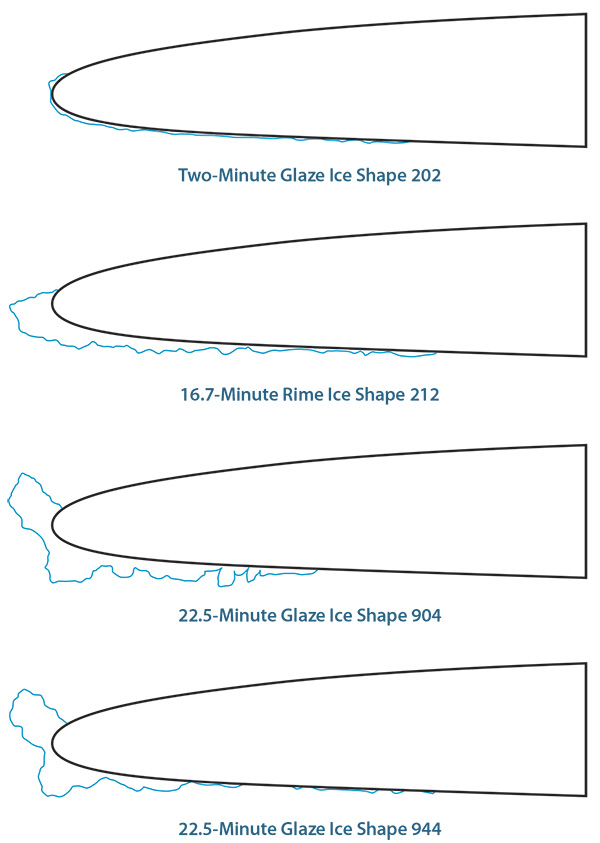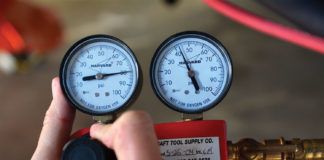Even though winter is now in the rear-view mirror for many of us, pilots can still face the possibility of dealing with one of nature’s great hazards to aviation: ice. Ice can be found at all times of year in various parts of the country (and the world)-especially in homebuilt aircraft that fly higher, faster, and farther than ever before.
Designers go to great lengths to shape airplanes so that the air flows smoothly over them. The airflow over the wings and other flying surfaces is quite sensitive to the surface texture of the skin.
Even a relatively small amount of surface roughness can cause large changes in the aerodynamic performance of an airplane wing. On an ordinary, old-fashioned, turbulent-flow wing, the combined effect of lap skin joints (9%) and exposed rivets (25%) increases parasite drag 34% over the same wing with smooth skin.
Environmental contamination of the skin surface can have even larger penalties. By far the most common source of contamination of wing surfaces is ice.
The aerodynamic effects of accumulated ice can change an efficient flying machine into a marginal or unflyable monster.
Icing can happen on the ground as well as in the air. The ice accumulations that occur on the ground are different than those in the air, but both can have serious consequences.

Cast Ice Shapes: Accumulated ice can drastically change the shape of the wing leading edge and damage its aerodynamics (From NASA TM-2003-212124).
Icing on the Ground
In recent years, ground icing has been implicated in several airline crashes. In each of these incidents, the airplane failed to climb after takeoff and stalled at an airspeed significantly above its normal stall speed. What is striking about these accidents is that the amount of ice on the airplanes was relatively small.
When the airplane is static on the ground, ice forms when precipitation freezes on the up-facing surfaces of the airframe. The ice consists of a large number of individual particles adhering to the surface. Each particle is formed by the freezing of a drop of water. The ice roughens the surface of the airplane, giving it a sandpaper-like texture.
It does not take much ice of this type to hurt the aerodynamic performance of a wing. The roughened surface disturbs and thickens the boundary layer. This causes a large increase in drag due to the increase in friction between the air and the wing. Roughening the wing surface to the texture of medium-grade sandpaper can increase drag by up to 40%.
Surface roughness also increases the likelihood of flow separation. This causes the wing to stall prematurely, reducing maximum lift and increasing stall speed. The same medium-sandpaper roughness that causes a 40% drag increase can reduce maximum lift by 30%. This will increase stall speed almost 20%.
The increased drag and higher stall speed will severely hurt takeoff and climb performance. The takeoff roll will be longer, and the rate of climb lower. In some cases, the airplane will not be able to take off and climb away safely. Even if the iced airplane could theoretically take off, the pilot will likely fail to take the effects of the ice into account when attempting the takeoff, and will stall the airplane.
Ground icing is a problem for the airlines because they operate in all but the most extreme weather conditions. Airplanes can accumulate ice and snow on the wings while taxiing for takeoff in winter weather. This is less of a problem for light airplane pilots, since very few of us try to take off in the kind of conditions that exist for the airline ground icing accidents.
What does get light airplane pilots in trouble is frost or snow/ice that has accumulated on the wings and tail while the airplane was parked at a tiedown. Cleaning it off can be a cold and time-consuming job. Pilots are often tempted to avoid this task particularly if there is “just a little frost” on the wings. They do not clean the wings and assume that the frost will evaporate during the flight. This can be a fatal mistake. A remarkably small amount of surface roughness can have a dramatic effect on performance. If there is enough ice, frost, or snow on the wings to see or feel if you run your fingers across the surface, then there is enough to cause serious performance degradation. It is never safe to attempt a takeoff with any ice, frost, or snow sticking to the flying surfaces of the airplane.
For light airplanes, ground icing accidents are quite avoidable, as long as the pilot does a thorough preflight inspection and takes the time to completely de-ice the wings and tail before the flight.
In-Flight Icing
In-flight airframe icing happens when moisture in the atmosphere comes into contact with the skin of the airplane at sub-freezing temperature. For ice to form there must be visible, liquid water in the air (cloud, mist, rain) and below-freezing temperature on the skin of the airplane. It is not necessary for the ambient temperature to be below freezing because the airflow over the wing, combined with evaporative cooling, can cool the skin to below freezing.
Icing happens over a relatively small range of ambient temperatures. If the suspended water in the atmosphere is already frozen it will not stick to the airplane, and if it is warm enough, the water will not freeze at all. Accordingly, typical icing conditions occur in an ambient temperature range from about 32 F to about 5 F. Icing does occasionally occur at temperatures outside this band, usually when the water that hits the airplane has recently passed through an area where the temperature is right for icing.
The most dangerous situation is when the water in the atmosphere is supercooled. It is still liquid, but at below freezing temperature. The supercooled water will freeze on impact with the airplane. In this case ice can accumulate very rapidly.
Icing can sneak up on a pilot because relatively small changes in outside air temperature (OAT) and moisture content of the air can change the situation from one where ice does not form to one where it does.
Unlike ground ice, in-flight ice tends to accumulate on the nose and leading edges of the flying surfaces. One reason in-flight icing is so dangerous is that the ice accumulating quickly changes the shape of the leading edges and drastically changes the aerodynamics of the wings and tail.
There are several types of ice accumulation. The type of ice and its shape depends on the droplet size of the water in the air.
Rime Ice
If the water droplets in the air are small, as in light drizzle or cold fog, they will freeze in place on impact. The ice forms as a collection of small particles like snow. The air between the particles makes the ice appear milky in color. Rime ice is relatively lightweight because of the included air, but it roughens the leading edges of the flying surfaces and changes their shape to a rough, irregular contour. Both of these effects increase drag and damage the wing’s ability to produce lift.
Clear Ice
If the droplets are large, clear ice will form. Clear ice is smoother and heavier than rime ice. Clear ice is more difficult to clear from an airframe because it is stronger and harder to break up. While de-icing boots will usually remove rime ice, which is brittle, a rapid clear ice buildup may prove too much for pneumatic de-icers.
When a large supercooled water drop hits the airplane, part of it freezes in place. The remainder flows downstream with the airflow, and eventually freezes. This “flow-then-freeze” sequence is part of what makes clear ice the most dangerous form of in-flight icing.
The water that freezes initially forms a relatively smooth buildup on the forward-facing surfaces of the airplane. The portion that flows aft before freezing tends to form a ridge as more and more water freezes in the same place. Once the ridge starts to form, its formation is accelerated by the fact that the ridge itself stops the aft movement of water, causing it to freeze onto the ridge and make it bigger. This process can build what is essentially an ice spoiler across the wing just aft of the leading edge.
The effects of such an ice ridge can be dramatic. In its early stages, the ridge reduces the maximum lift capability of the wing and increases drag. The drag may increase to the point where the airplane is unable to maintain level flight at full power.
As the ridge grows, it may cause the flow over the wing or tail to separate completely. When this happens, the airplane will become uncontrollable. If ice causes the tail to stall, an uncontrolled dive or pitch-up will result. If the airflow over the wing is destroyed, it may not be able to generate enough lift to sustain flight.
Another aerodynamic effect of clear ice ridges on the wing is loss of lateral control. Several years ago, an ATR-42 commuter airliner departed in roll and crashed in freezing rain in the Midwest. Later investigation showed that although the de-icing boots on the airplane were effective in removing ice from the area covered by the boots, enough supercooled water was making it downstream of the boots to form an ice ridge aft of the boots. When the ridge got large enough to cause flow separation on the outer portion of the wings, lateral control was lost, and the airplane crashed. The de-icing system and operating procedures for the airplane have since been modified to prevent a reoccurrence.
It is important to ensure that de-icing systems can effectively clear all critical flying surfaces of ice. Some years ago, I was involved in an investigation of an ice-related light-twin accident. The accident airplane had de-icers on the wings outboard of the engines, but no de-ice on the small portion of wing between the fuselage and the engine nacelles. This small portion of the wing iced up and stalled. The center of the wing lost lift, and the disturbed airflow from the center section reduced the effectiveness of the horizontal tail. These two effects made it impossible for the pilot to keep the nose up, and led to the accident.
Ice Survival
Unlike other meteorological hazards, the effects of icing continue after the airplane has flown out of the weather that caused the ice to form. Icing is also very hazardous because the condition of the airplane deteriorates steadily as long as additional ice is accumulating. An unwary pilot can find himself faced with a rapidly worsening situation with no easy escape.
Here are a few hints to improve your chances of survival.
Most importantly, avoid icing conditions if at all possible. If your airplane is not equipped for flight into known icing, stay on the ground if icing is forecast. More than one pilot has died trying to climb through an icing layer in an airplane without anti-ice equipment. This is a foolhardy thing to attempt, since your survival depends on penetrating the icing layer quickly enough. As you climb, the accumulating ice is reducing your airplane’s ability to keep climbing. You are likely to fall out of the sky inside an aluminum-filled hailstone.
If you encounter icing in an airplane that is not equipped for it, don’t wait to take action. Climb, descend, divert, or land as necessary to get out of the icing conditions immediately. Delay can be fatal. Ice accumulation can render an airplane unflyable in a remarkably short time, so any encounter with in-flight icing in an airplane that is not equipped with effective de-icing equipment should be treated as a life-threatening emergency.
If you have to land an iced-up airplane, remember the effect of ice on lift and drag. Keep your airspeed up on approach. Fly a higher, steeper approach to ensure that you will make the runway, and be prepared to land hot. Your stall speed may be 20 to 30% higher than for a clean airplane. Adjust your approach speed accordingly and keep your maneuvers gentle and your turns shallow. Also remember that drag will be higher. The airplane will sink more rapidly when power is reduced, and may not be able to execute a successful missed approach.
Ice can destroy the aerodynamic efficiency of an airplane with surprising speed. All pilots should be very aware of the danger posed by this atmospheric hazard.
Recommended reading:
Information on icing and its effects can be found in FAA Advisory Circulars (AC) 20-117 and (AC) 00-6A. These are available online from FAA.gov.
For a truly gripping account of flight in extreme icing conditions, I highly recommend Ernest K. Gann’s Fate is the Hunter. It contains an account of flying a DC-2 in conditions where clear ice buildups on the airplane exceeded four inches in thickness. Somehow, Gann and his passengers managed to survive.

![]()
Barnaby Wainfan is a principal aerodynamics engineer for Northrop Grummans Advanced Design organization. A private pilot with single engine and glider ratings, Barnaby has been involved in the design of unconventional airplanes including canards, joined wings, flying wings and some too strange to fall into any known category.














Hi Barnaby, I am designing an aircraft similar to a Cessna 150 and intend to use one of the Riblett laminar airfoils. I bought your excellent book “Airfoil Selection” but couldn’t find references or comments about those airfoils. So I’d very much appreciate to hear your opinion about them.
Thanks a lot!
Respectfully,
Justin Zaragoza, Jacksonville, FL
Aircraft Structures Engineer (425) 492-6390